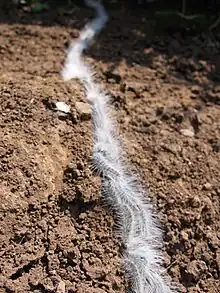Thaumetopoea solitaria
Thaumetopoea solitaria is a moth of the subfamily Thaumetopoeinae in the family Notodontidae first described by Christian Friedrich Freyer in 1838. It is found in Anatolia (including Turkey), on Cyprus, east to Syria, Israel, Lebanon, Iraq and Iran.
| Thaumetopoea solitaria | |
|---|---|
 | |
| Scientific classification | |
| Domain: | Eukaryota |
| Kingdom: | Animalia |
| Phylum: | Arthropoda |
| Class: | Insecta |
| Order: | Lepidoptera |
| Superfamily: | Noctuoidea |
| Family: | Notodontidae |
| Genus: | Thaumetopoea |
| Species: | T. solitaria |
| Binomial name | |
| Thaumetopoea solitaria (Freyer, 1838) | |
The wingspan is 20–28 mm for males and 25–35 mm for females. The moths are on wing from August to September.
The larvae feed on various species of Pistacia, among which: Pistacia terebinthus, Pistacia atlantica, and Pistacia palaestina.
Sources
- P.C.-Rougeot, P. Viette (1978). Guide des papillons nocturnes d'Europe et d'Afrique du Nord. Delachaux et Niestlé (Lausanne).
This article is issued from Wikipedia. The text is licensed under Creative Commons - Attribution - Sharealike. Additional terms may apply for the media files.